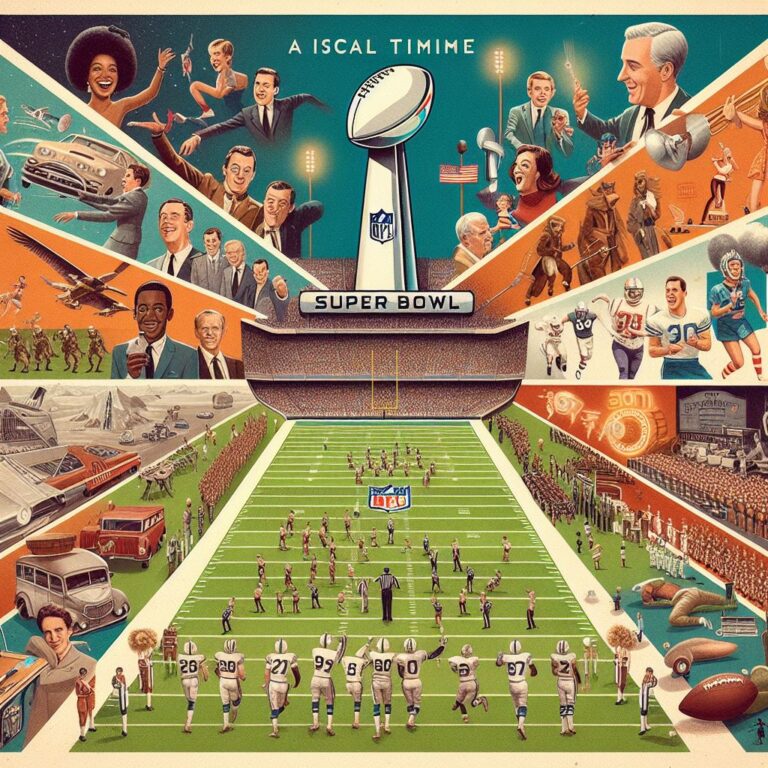The Super Bowl, an annual championship game of the National Football League (NFL), is more than just a sporting event. It transcends mere touchdowns and tackles; it’s a cultural phenomenon, a spectacle that unites fans and non-fans alike. As we delve into the rich history of the Super Bowl, we’ll explore its evolution, memorable moments, and the profound impact it has had on American culture.
Origins and Evolution
The Super Bowl’s journey began in the mid-20th century, a time when the NFL and the American Football League (AFL) were fierce rivals. Picture this: it’s 1966, and the merger of these two leagues gave birth to the Super Bowl—a grand showdown between the champions of each conference. The inaugural Super Bowl took place in 1967, with the Green Bay Packers emerging victorious by defeating the Kansas City Chiefs. Since then, the Super Bowl has grown exponentially, evolving from a mere game into a week-long extravaganza.
The halftime show, the commercials, and the parties have become as iconic as the game itself. It’s no longer just about touchdowns; it’s about unity and shared experiences. Families gather around their TVs, friends host watch parties, and even non-football fans tune in for the commercials. The Super Bowl has become America’s unofficial second Thanksgiving—a day when rivalries fade, and everyone becomes part of a collective narrative.
Memorable Moments
Joe Montana’s Precision
Let’s rewind to Super Bowl XXIII. The San Francisco 49ers faced the Cincinnati Bengals in a nail-biting clash. With the game tied and less than three minutes on the clock, quarterback Joe Montana stepped onto the field. His precision was akin to a surgeon delicately stitching up a wounded player. Montana orchestrated a masterful drive, his pinpoint passes leading the 49ers to victory. And then, in a moment etched in football lore, he found John Taylor in the end zone for the game-winning touchdown. Montana’s calm under pressure became the stuff of legend—a symphony of skill and determination.
The “Helmet Catch”
Fast forward to Super Bowl XLII. The New England Patriots were chasing perfection, aiming for an undefeated season. But fate had other plans. Enter David Tyree, a relatively unknown Giants receiver. With the ball seemingly glued to his helmet, Tyree made a miraculous catch, defying gravity and the Patriots’ defense. The “Helmet Catch” symbolized determination and improbable success. It was as if he had plucked victory from the jaws of defeat, like a painter adding the final brushstroke to a masterpiece.
Janet Jackson’s Wardrobe Malfunction
Super Bowl XXXVIII’s halftime show featured Janet Jackson and Justin Timberlake. But it wasn’t Timberlake’s dance moves that stole the spotlight; it was the infamous wardrobe malfunction. As Timberlake sang, “I’m gonna have you naked by the end of this song,” he accidentally exposed more than just lyrics. The incident sparked debates about censorship, artistic expression, and the power of live television. It was a moment when the stage became a canvas, and the world watched as boundaries blurred.
Dominance of Titans
The Dynasty of the New England Patriots
When it comes to dominance, the New England Patriots stand tall like a colossus. Led by the enigmatic coach Bill Belichick and the unflappable quarterback Tom Brady, the Patriots redefined excellence. Their dynasty spanned two decades, capturing six Super Bowl titles in the process. Picture this: a team that consistently reached the pinnacle of success, their blue-and-silver uniforms gleaming under the stadium lights.
The Patriots’ dominance wasn’t just about winning; it was about meticulous preparation, adaptability, and resilience. They were the chess masters of football, anticipating opponents’ moves and countering with precision. Whether it was the “Tuck Rule” game against the Raiders or their epic comeback against the Atlanta Falcons in Super Bowl LI, the Patriots etched their legacy in pigskin folklore. Their dominance wasn’t flashy; it was methodical—a symphony of strategy and execution.
The Steel Curtain: Pittsburgh Steelers
In the 1970s, the Pittsburgh Steelers forged a dynasty that reverberated through time. Their defense, aptly named the “Steel Curtain,” was an impenetrable fortress. Imagine a wall of iron and grit, adorned with names like Joe Greene, Jack Lambert, and Mel Blount. The Steelers won four Super Bowls in six years, leaving opponents battered and bewildered.
Their offense wasn’t too shabby either. Terry Bradshaw, the gunslinger quarterback, connected with Lynn Swann and John Stallworth in balletic touchdown catches. The Steelers weren’t just a team; they were a force of nature. Their dominance was like a blacksmith’s hammer shaping destiny—a blend of brute force and finesse.
In conclusion, these dominant teams—whether clad in red, white, and blue or donning the black-and-gold—have left an indelible mark on the Super Bowl tapestry. Their legacies echo through stadiums, their triumphs etched in silver and gold. So, as we celebrate each Super Bowl, let’s tip our imaginary hats to these gridiron giants.
Impact on American Culture
The Super Bowl isn’t just about football; it’s a feast for the senses. Imagine it as a giant melting pot where teams from different backgrounds clash, representing their cities and fans. Each player is an instrument, each play a note in a symphony of anticipation. And when the confetti rains down on the winning team, it’s a crescendo of joy and celebration—a communal experience akin to Thanksgiving feasts.
In summary, the Super Bowl is more than a game; it’s a cultural touchstone. From Joe Montana’s precision to Janet Jackson’s wardrobe malfunction, it weaves moments into the fabric of American history. So whether you’re a die-hard fan or a casual observer, the Super Bowl invites you to join the huddle, cheer for your team, and savor the magic of the gridiron.
Check out more sports related articles at Sports Archives – Topic In One Article
